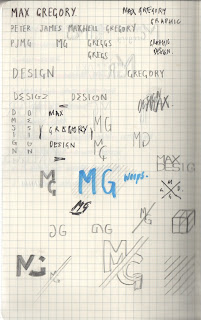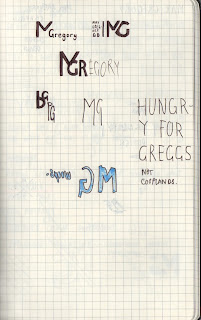This was a process I wasn't particularly excited to begin, because although it is very important in the development of a professional appearance for any designer, it was something I had stumbled on many times before. I've heard many people say (including John) that branding yourself is one of the hardest things you could do as a designer and previous excursions into this area had proved this.
So I began as simply as possible, using my name in order to create some kind of logo. Below are some initial sketches from my notebook in which I looked at the use of letters within my name that gave good visuals when placed together. I also looked at playing with the letters in the word design in order to make them read as design but make out the initals of my name. There were a few avenues from these sketches that I thought could be interesting to follow so I then moved over to digital.
My initial experimentation revolved around the word design, as I thought that turning the M as my first inital could look like an E in the word design. It was then a case of using the word in a way that could pick out my initials from the rest of the letters. This involved looking at the orientation and use of colour. felt these were OK, but I wanted something much simpler that still had the same effect.
Above were variations in a logotype that I worked on taking my initals and joining them to create something interesting visually. The first is a very convoluted example, however the second I think is much improved, simplified, using a diagonal split between the M & G and matching the letters along the diagonal of the M. I was very pleased with this example but moved on looking and ways of simplifing it further to give a much smaller impression on the page but keeping the same effect.
However the more I looked at this logo, the more I realised I didn't want a logo. although it could be applied to my branding, I feel that I am not a designer that wants to focus on logo, and the development of a logotype for myself would be much more reflective of my own practice.
Although very simple, I felt the above examples were the best and most reflective of my own design. Since writing about Swiss design for my CTS I have become very interested in the international typographic style and feel that knowing so much about their practice has had an effect on my own. This is where the inspiration for a few of these examples is drawn from, however I didn't want to come across as a designer that only does this kind of design, so keeping it neutral and simple gives both the modernist and flexible sides.














No comments:
Post a Comment